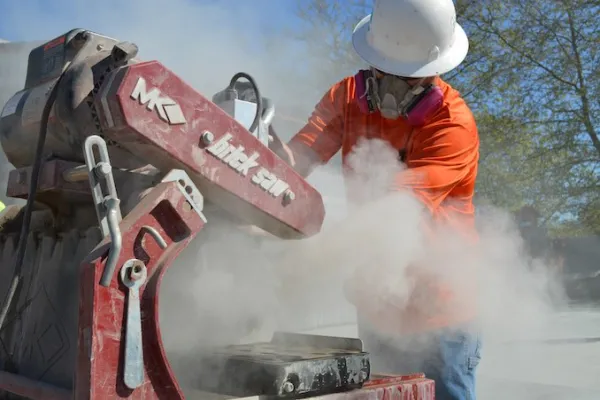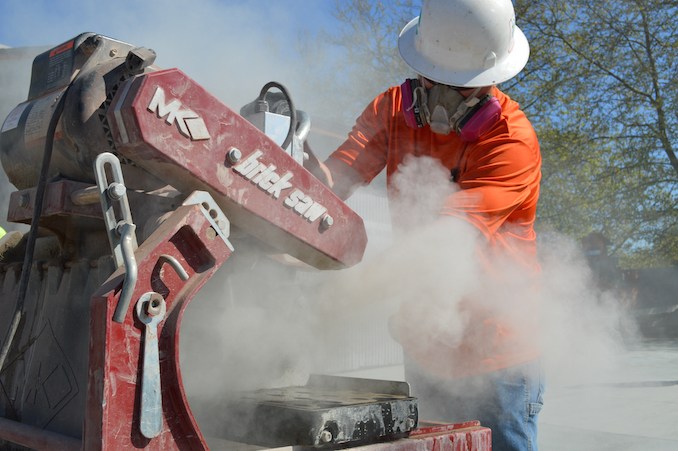OSHA Silica Standards announced March 24

The new “silica standard”— announced March 24 by the Occupational Safety and Health Administration (OSHA) — will cover as many as 2.3 million workers. They’re in construction, on road crews, in shipyards, and in foundries, glass-making and fracking — all those who use sand or who saw, drill, blast and crush rock, brick, or cement. Those activities generate airborne microscopic crystalline silica particles 100 times smaller than ordinary sand. The particles aren’t caught by the body’s filter mechanisms and instead go right into the lungs. Over time, they can cause crippling and fatal lung diseases like silicosis, chronic obstructive pulmonary disease, and lung cancer. The new rule will require employers to control silica dust using vacuums or water, or have workers wear respirators when those other methods aren’t feasible.
AFL-CIO workplace health expert Peg Seminario — who has fought for better silica protections since today’s construction apprentices were in diapers — calls it the most important new OSHA rule since the agency got serious about asbestos in 1986.
INDUSTRY FIGHTS BACK
Within weeks of OSHA’s announcement, industry groups filed multiple lawsuits to try to stop it. They may try to stop it in Congress as well.
“We know they’re up on the Hill asking their Republican friends to put riders in appropriations bills, ordering OSHA not to enforce it,” Seminario said.
But President Barack Obama has pledged to veto any attempts to undo the silica rule, and the law that created OSHA is very clear about the agency’s authority to write rules protecting workers health. Seminario is confident the silica rule will hold up in court.
Each year, an estimated 600 workers die from the effects of breathing silica dust, and thousands more are short of breath and in pain after decades of hard work. To prevent that, the new rule sets a “permissible exposure limit” of 50 micrograms of respirable crystalline silica per cubic meter of air. That limit was first recommended by the National Institute for Occupational Safety and Health (NIOSH) — in 1974.
“Unfortunately, it has taken over 40 years for the politics to catch up with the science,” said Labor Secretary Thomas Perez at the March 24 press conference announcing the rule.
When OSHA sets a limit for hazardous chemicals, it normally requires employers to collect air samples and send them to a lab to show the workplace is under the limit. But because construction industry groups argued that would be too expensive, North America’s Building Trades Unions worked with OSHA to come up with a better way. The new rule for the construction industry contains a list of tasks, along with what can be done to control dust for each task, like a vacuum hose or water that goes directly to where the silica dust is generated. If employers follow those methods, they don’t have to collect air samples, give employee medical exams, or take other measures.
[caption caption="WHAT’S MISSING FROM THIS PICTURE? DUST. Bricklayer apprentice Tristan Burke operates a brick saw with a water hose attachment. Below, apprentice Robert Griggs operates the same brick saw without the water — generating the dust that causes silicosis." align="right"] [/caption]
[/caption]“In the construction industry, it’s very simple,” says Chris Trahan, top worker safety expert for North America’s Building Trades Unions. “You wet it down. You suck it up. If you control the dust at the source, you’re done. You don’t have to do anything else.”
Trahan, an industrial hygienist and former OSHA compliance officer, says the new silica rule will make a huge impact on the construction environment: “You’re not going to walk down the street and see plumes of dust when construction workers are cutting the curb or sidewalk.”
“We’re going to see a reduction in disease,” Trahan said. “[Diseases of the lung] are a huge issue for construction workers, and our research has shown over and over again that silica is a major contributor.”
In construction, the unions whose members are most affected include Laborers, Operating Engineers, and Bricklayers and Allied Crafts (BAC). Fittingly, OSHA announced the rule at BAC’s national training center in Bowie, Maryland. But plenty of other building trades workers will benefit. On construction sites, anyone who breathes in the dust or sweeps it up is at risk — not just the workers who grind and cut.
[caption caption="NO DUST HERE: Bricklayers apprentice Krista Kiser grinds a mortar joint with a vacuum attached." align="left"] [/caption]
[/caption]“The biggest thing you’re going to see is less dust,” said Bricklayers Executive Vice President Gerard Scarano. “You’re also going to find better educated workers who know more about the hazard and the tools they need to use.”
The rule takes effect June 23, but OSHA is giving employers a grace period to figure out how to comply. It won’t begin enforcing the rule for a year in the construction industry, two years in general industry, and five years in the fracking industry.
But responsible employers are already taking measures to reduce silica. The Labor Press will happily list the names of any local union-signatory contractor that is already complying with the OSHA silica standard.

